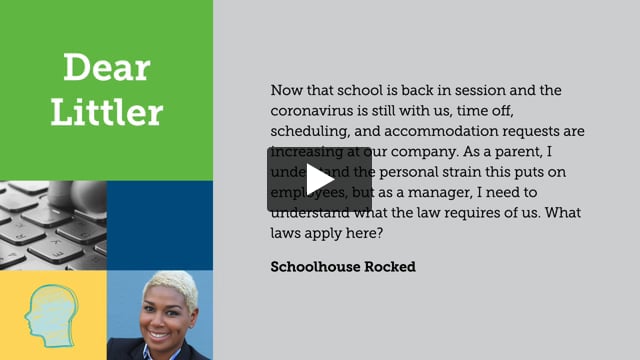Information contained in this publication is intended for informational purposes only and does not constitute legal advice or opinion, nor is it a substitute for the professional judgment of an attorney.
UPDATE: On August 27, 2020, the U.S. Department of Labor (DOL) published three new “Return to School” FAQs (here, here & here). Notably, DOL says that, if parents can choose between in-person and remote learning, and select the latter, FFCRA leave is not available. It says leave is available if a school is currently operating entirely remotely, but might be unavailable later if the school switches to in-person learning only. Finally, when a school alternates between in-person and remote learning days, DOL says leave is available, but only on remote learning days.
Dear Littler: Our company operates in multiple locations across the country. Some schools in these jurisdictions are proceeding with normal in-class instruction, others are using a hybrid model where students shift between in-person and remote learning during the week, while others are offering remote learning only. And some schools have already altered their original plans and may change even again before school actually resumes. These scheduling uncertainties are making it increasingly difficult for our employees, who are parents with school-age children, to balance their work and parental responsibilities. As a result, more employees are requesting time off, flexible schedules, or other accommodations to care for their children. As a parent, I understand the personal strain this puts on employees, but as a manager, I need to understand what the law requires of me and the company. What laws apply here?
—School House Rocked
* * *
Dear School House Rocked,
The universe of laws that might apply is vast and expanding. Some laws came about solely to address the COVID-19 crisis, like the federal Families First Coronavirus Response Act (FFCRA), which provides up to 80 hours of emergency paid sick leave, and up to 12 weeks of emergency family leave for various reasons, including those involving school closures and the unavailability of childcare providers. Similarly, better known pre-coronavirus leave laws, such as paid sick leave and unpaid family leave, were amended or interpreted to add protections for absences that are the result of this public health emergency. It’s not just leave laws that employers need to consider, however; scheduling laws might apply, anti-discrimination protections could be triggered, and rarely invoked laws that are event-specific, such as protections during a declared emergency, find purpose during the pandemic.
COVID-Specific Leave
If a business has 499 or fewer employees in the United States, the federal FFCRA allows employees to take up to 14 weeks of job-protected leave if they need to care for a child whose school or place of care is closed, or childcare provider is unavailable, due to coronavirus precautions. According to the U.S. Department of Labor, this includes situations where a:
school or place of care has moved to online instruction or to another model in which children are expected or required to complete assignments at home. . . . This is true even if some or all instruction is being provided online or whether, through another format such as “distance learning,” your child is still expected or required to complete assignments.
Although some employees might take only—and max out at—12 weeks of FFCRA leave paid at two-thirds their regular rate (subject to the monetary cap), others might have a need to use more than 12 weeks of leave, and want to ensure that job protections cover as much of an absence as possible, so they will opt to take the first two weeks of unpaid leave, followed by the 10 weeks of paid leave, under the FFCRA's Emergency Family and Medical Leave Expansion Act, capped off by an additional two weeks of paid leave under the FFCRA's Emergency Paid Sick Leave Act. Similarly, many states, counties, and cities have enacted emergency paid sick leave laws (modeled after the FFCRA), which allow employees to use leave for childcare reasons, though these laws provide up to a maximum of 80 hours of leave. Some of these laws apply to employers and employees the FFCRA covers already, but others apply only to those it does not (e.g., employers with 500 or more employees). If a "mini-FFCRA" law applies, although many jurisdictions model their laws on the FFCRA, there might be notable differences, such as paying employees their full regular rate for childcare absences rather than two-thirds the employee’s rate of pay.
As noted above, a school can be open yet “closed” for FFCRA and/or mini-FFCRA purposes. For example, a school might offer remote learning only or hybrid learning where students receive in-person and remote instruction on an alternating schedule. For the latter, although in-person learning is available, that fact alone might not determine whether employees can use leave if their child does not physically attend class that day. Is in-person attendance mandatory or optional? If not an either/or choice, does the school offer child- or fact-specific exceptions to the rule that a child must attend the in-person component? Employees might be out of options, however—from at least an FFCRA and/or mini-FFCRA standpoint—if they unilaterally decide to keep a child out of school on in-person instruction days.
Family Leave
Employees might be entitled to take weeks of unpaid job-protected family leave under state or local law. Notably, employees may be able to convert this time to paid leave if they use existing employer-provided benefits. During the COVID-19 pandemic, mini-FMLA laws in the District of Columbia and New Jersey, and regulations in Oregon, were amended to allow leave when employees need to care for kids whose schools or places of care are closed due to a public health emergency.
School Activities Leave
Based on name alone, you might overlook "school activities leave" laws, but remember your high school Shakespeare: "What's in a name?" Don't read every third line of a law to get the gist of it, or rely on the Cliffs' Notes version. For example, in addition to covering events like enrolling a child in school, addressing school discipline issues, or participating in activities of the school, California's school activities leave law deals with the closure or unexpected unavailability of a child's school or childcare provider. Other laws cover school/child emergencies, which might arise when schools offer in-person learning.
Paid Sick and Safe Time
Earlier this year, there were many assemblies held to address an issue that was popping up on (business) campuses throughout the country: whether, when, and to what extent, mandatory paid sick and safe time (PSST) laws in 30-plus jurisdictions allow employees to use leave when a school or place of care closes due to a public health emergency. Because these "other" types of absences were rarely (if ever) discussed in depth previously—in the law itself, or in rules or FAQ—the assembly turned into a fire drill. Some regulators added fuel to the fire when they began implementing emergency rules or guidelines that expanded previously covered reasons to now include school and childcare closures as a result of the pandemic. Although it is possible employees might have already used their maximum allotment of PSST leave this year, some jurisdictions do not have annual use caps. Who knows how long COVID-19 will linger, so, even if an employee exhausted leave in one benefit year, when the new benefit year begins, the use clock resets and employees can once again take protected leave. What remains to be seen is whether regulators will paint with as broad a brush when schools are not closed-closed, as they did earlier during the COVID-19 crisis.
Kin Care Laws
Just as in-person education was the predecessor to remote learning, so too was kin care to paid sick and safe time. Generally, kin care laws provide that, if an employer offers employees paid leave they can use for certain reasons (normally sickness and medical care), they must allow employees to use a certain amount of that leave to care for or assist a family member. You might ask, "What does this have to do with school or childcare closures?" Above, we addressed instances in which a child cannot physically attend school or childcare because it is closed. What about if schools are open? Or open some days and not others? As recent news reports highlight, in schools throughout the country, student COVID-19 positivity rates are increasing. Children are not immune, so parents have concerns about the safety of their children, themselves, family members or others residing in their home and with whom their child will have regular contact. With COVID-19, we're in uncharted territory, so keeping a child home for “preventive care” might be sufficient to trigger kin care protections in certain jurisdictions.
Scheduling Laws
After so much "indoor" learning, let's go outside (leave laws) for a short recess. More a big city than state- or nation-wide concern, scheduling laws come in various shapes and sizes. Some apply generally (e.g., in Vermont), while others only to employers in specific industries and/or of a certain size (e.g., in Seattle, Washington). Family-friendly workplace laws (e.g., in San Francisco, California) are more limited in what they require than predictive-secure scheduling laws (e.g., in Chicago, Illinois), but both require employers to engage in good-faith discussions with employees about scheduling flexibility. Additionally, if employers grant an employee's request to work fewer, different, or more certain hours to accommodate a need to care for children because of school or place of care issues COVID-19 caused, this might have a knock-on effect under predictive-secure scheduling, or other laws that require employers to offer part-time employees available hours before they hire new employees to work those hours (e.g., in Philadelphia, Pennsylvania).
Other Considerations
Some laws might come into the picture based on how employers administer leave or accommodation requests. For example, in South Dakota, employers cannot provide child care leave that discriminates based of sex, and under the Texas kin care law, foster children cannot be treated differently than biological or adopted children. Additionally, state or local fair employment laws might prohibit discrimination based on familial status or family responsibilities and/or based on an employee's association or relationship with a person with a disability (which might be the reason a parent needs to keep a child out of school).
Given we find ourselves amidst a public health emergency, don't ignore protections that might apply during declared emergencies. For example, Maine employers must grant reasonable and necessary paid or unpaid leave related to an extreme public health emergency because employees are unable to work when they must provide care or assistance to their children.
Don’t forget everything you knew before the pandemic. If you only look at a situation within the scope of recent legislation, you might miss the low-hanging fruit and accommodations you might have been providing for years.
Final Thoughts
Once you locate the puzzle pieces, you need to determine whether and how they fit together, if at all. This will present an administrative challenge, not only the first time an employee takes a leave of absence but also throughout the coronavirus crisis. Although multiple laws might cover a type of absence, they might not all cover the employee, at least not simultaneously. Some laws might be of limited duration like the FFCRA, currently set to expire on December 31, 2020, whereas others will continue to exist in 2021. The laws, or an employer's policies, might employ a different year for purposes of determining how much of a type of leave an employee can take annually.
Moreover, employee eligibility standards could vary. For example, although two different laws may cover a single situation, employees might not yet qualify to use Leave A, although they qualify to use Leave B. Therefore, when they eventually qualify for leave under Leave A's law, they may have already exhausted their Leave B entitlement. In such a situation, employees may use both leaves consecutively, rather than concurrently, increasing the amount of time they will, and can legally be, absent from work. Related, do not expect a pre-existing law to address whether it runs consecutively or concurrently with a later-enacted law, or a recent law to address how it interacts with every other potentially applicable law.
So to sum up, School House Rocked, there are a number of federal, state and local laws that could require you to provide your employees with protected time off to address their childcare needs during COVID-19. Ready yourself for some (more) uncertainty, recognize you might need to be flexible, and be open to partnering on developing workable solutions so you, your company, and your employees can successfully adapt to this ever-changing environment.





